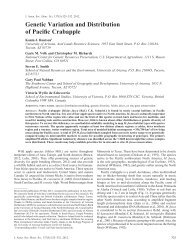CONSERVATION
Conservation You Can Taste - The Southwest Center - University of ...
Conservation You Can Taste - The Southwest Center - University of ...
- No tags were found...
You also want an ePaper? Increase the reach of your titles
YUMPU automatically turns print PDFs into web optimized ePapers that Google loves.
of bringing people on a visit of farms and flavors<br />
in the borderlands of southeastern Arizona.<br />
The idea for the tours emerged out of innovative<br />
collaborations among the University of Arizona’s<br />
College of Social and Behavioral Sciences and its<br />
the Southwest Center, the Santa Cruz Valley Heritage<br />
Alliance, the City of Tucson, and Pima County Parks<br />
and Recreation Department. We focused on foods<br />
recently nominated or already boarded onto the Slow<br />
Food Ark of Taste. Our journey began in Tucson, at<br />
the San Agustin Mission Garden, where the Friends<br />
of Tucson’s Birthplace have worked to create a fouracre<br />
reconstruction of the original mission garden. It<br />
features heritage fruit trees such as Sonoran quince,<br />
Papago pomegranate, Mission grape, Mission olive<br />
and Mission fig trees, as well as traditional field crops<br />
of the region. We then visited the San Xavier Coop<br />
Farm where racks of a variety of O’odham 60-day<br />
corn dried along with red chiles and mesquite beans.<br />
A Tohono O’odham elder explained the process of<br />
grinding the dried corn and grinding the mesquite to<br />
make traditional dishes. Tour participants also had<br />
the opportunity to purchase green striped cushaw<br />
squash, yellow-meated watermelons, mottled lima<br />
beans, and tepary beans—all foods with a long tenure<br />
in the desert Southwest. We followed the Santa Cruz<br />
River upstream toward the Mexican Border, retracing<br />
a river corridor that has served as a circulatory system<br />
for farming peoples, migrants, and explorers through<br />
millennia. We also visited the Tumacacori National<br />
Historic Park to visit the mission, learn of Spanish<br />
acequia (canal) systems and see the young Kino Fruit<br />
Trees Orchard with its heritage fruit varieties. The<br />
51



